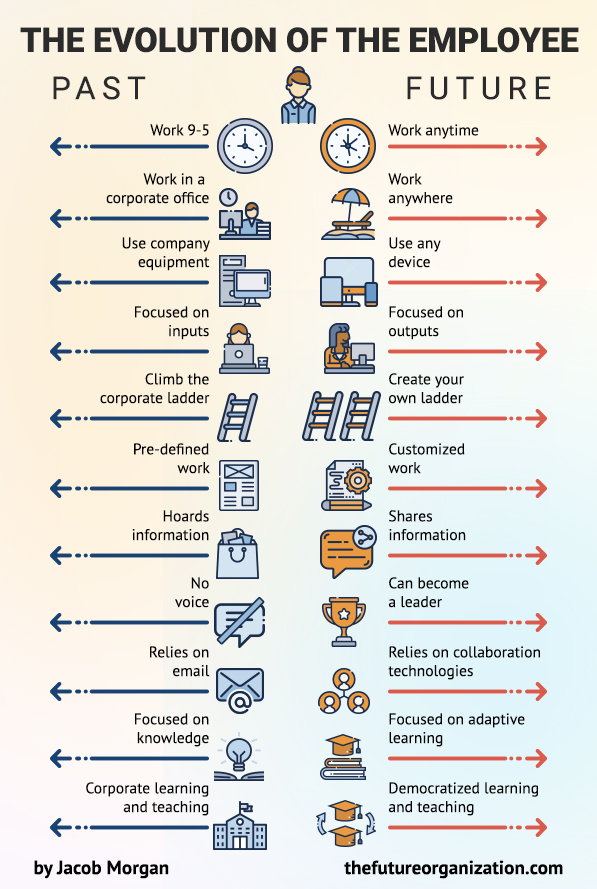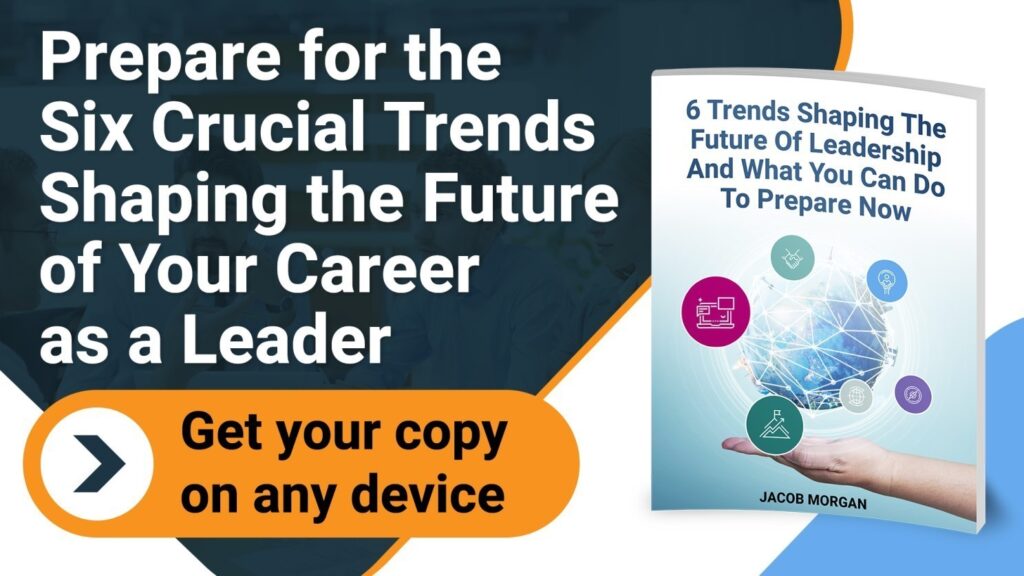The current COVID-19 epidemic we are all experiencing is forcing organizations around the world to challenge their conventional ideas around work. In this article I specifically want to take a look at how the “employee” is evolving. If you look up the word “employee” in the dictionary you will actually find that synonyms for the word employee include: cog, servant, and slave. This is how we have thought about our workforce for decades, as expendable and replaceable resources. We need to change that.
In 2014 I wrote a best-selling book called, The Future of Work and I developed a concept in there called “The Evolution of the Employee” which shows how this mentality is changing. This change has been quite slow but COVID-19 has made this evolution a present day reality.
This is how employees are evolving and what organizations around the world need to embrace, prepare for, and encourage.
Truly flexible work
The first two items above along with “focusing on outputs” comprise this idea of flexible work, that is working anytime, anywhere, and being evaluated not by how many hours you sit in a chair but by what you produce. There is no longer a need for most employees to work from an office or to work 9-5. COVID-19 has clearly shown us that with millions of people around the world being forced to work remotely. However some organizations out there like Unilever, Cisco, Microsoft, and Aetna have been offering flexible work for years. The future of work = flexible work.
Use any device
Gone are the days of company sanctioned phones and computers. Instead, the future employee will be able to use any device they chose to get their jobs done. Companies like Ford, IBM, and Intel, have been among those leading the way in allowing their employees to use many personally owned devices for work. With the blurring and integration of work and life this is the new norm.
The death of the “ladder” and customized work
When you start working for a new company usually you start off at the bottom of the proverbial totem pole. In other words you begin as a sales coordinator, then a sales manager, senior sales manager, sales director, and so on and so forth. You have to climb the ladder for a few years in the hopes that one day you will reach a position that you are happy with. However with the gig economy, collaboration platforms, and new leadership approaches; employees are now starting to shape their own career paths and how they actually work. Those who are able to build the strongest personal brands for themselves will be able to have the greatest influence in shaping their own career paths.
Sharing is caring
Employees use to hoard information and keep it to themselves. There was no incentive, scalable way, or reason for employees to share what they know with others. Knowledge is power and if employees keep their ideas to themselves then they have the power. Employees were also not encouraged to share or think creatively, their job was merely to show up to work and perform their tasks…that’s it! For the future employee the exact opposite is true. Collaboration platforms are making it easy for employees to share information and organizations are creating incentives to do this ranging from internal incubators to intrapreneuer programs to open innovation programs. We are also seeing a shift from focusing on individual performance to focusing on team performance which does a far better job of encouraging employees to work together.
Going forward any employee can have an idea that can turn into a new product, service, or opportunity. Shell with their GameChanger program and Whirlpool with their “Winning Workplace” program are just two examples of organizations that are shifting their culture from hoarding to sharing.

Anyone can be a leader
As mentioned above employees were thought of as being expendable cogs which meant they had no voice within the organization. Once again, collaboration technologies play a crucial role as they give any employee within an organization the chance to be a recognized leader by sharing their ideas, thoughts, concepts, etc. Any employee that is able to build a following with the content they share internally is capable of being a leader; something which was not possible before especially not at the scale that collaboration platforms allow today. Think of how many people have become leaders as a result of social platforms such as Twitter, Instagram, or Facebook, now employees can do the same inside of their companies. Of course doing this also means embracing a new set of skills and mindsets required to lead.
Knowledge vs adaptive learning
Knowledge is now nothing more than a commodity. To be the world’s smartest person all you need to do is pull out your cell phone where you can get answers to anything. This means that for the future employee it’s not knowledge that is the most important but the employee’s ability to learn new things an apply those learnings to new situations and scenarios that come up. In other words, always being able to learn how to learn and stay adaptable. This is far more important and valuable than what you “know.” In other words, think of yourself like an app!
Everyone is a teacher and a student
In most organizations today if you want to learn something you have to sign up for and attend a class that may be a few days or a few weeks away. Today (again thanks to collaboration platforms) any employee can take out their cell phone and record a “how-to” for anything ranging from setting up a modem to programming something on excel to learning active listening techniques. Simply being able to connect employees to each other provides a way for democratized learning and teaching in ways that were never before possible. Thanks to sites such as Udemy, Youtube, Coursera, and Khan Academy we have the ability to learn what we want to learn and teach what we are uniquely qualified to offer to others.
We need to redefine what “employee” means. We are not expendable and replaceable cogs. We are human beings with ideas, passions, fears, relationships, and solutions. The world of work is constantly changing but there is one thing that I can promise you. If your organization doesn’t change how it thinks about the people who work there then it won’t be in business much longer, nor should it!
How do you define “employee?” Share below!
. . .
There are 6 trends that are transforming leadership forever do you know what they are and are you ready for them? Download the PDF to learn what these 6 trends are and what you should be doing about each one of them. These are crucial for your leadership and career development in the future of work!

Comments